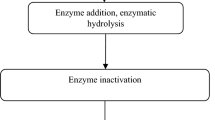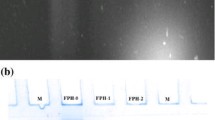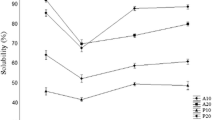Abstract
In this study, we evaluated the effect of complexation and microencapsulation with pea protein on the antioxidant activity of protein hydrolysates from bycatch in Brazil. The zeta potential values of complexes changed from negative to positive with the increase of pea protein as a result of positively charged complexes formation. The increase in the ratio of pea protein/hydrolysates also resulted in increased turbidity in all samples. Particle size measurements indicated that the complexes tended to form larger aggregates (ranged from 61.5 ± 1.7 μm to 183 ± 2.8 μm). The 2,2-diphenyl-1-picrylhydrazyl (DPPH) radical scavenging activity of the pea protein/fish protein hydrolysate complexes was higher than that of the protein hydrolysates alone. Moreover, increasing levels of pea protein did not affect the antioxidant activity of fish protein hydrolysates. The complexes of the Paralonchurus brasiliensis were chosen for the microencapsulation process by spray-drying. The results revealed that spray-drying did not have a significant effect (P > 0.05) on the protein hydrolysate antioxidant activity when they were complexed with pea protein. Thus, this work suggests that the complexation with pea protein and subsequent microencapsulation by spray-drying is an efficient way to protect the biological activity of protein hydrolysates obtained from bycatch. This study provides evidence for the potential use of bycatch from shrimp fisheries as functional ingredients or nutraceuticals.





Similar content being viewed by others
References
Abuine R, Rathnayake AU, Byun H-G (2019) Biological activity of peptides purified from fish skin hydrolysates. Fish Aquat Sci 22:10
Akbarbaglu Z, Mahdi Jafari S, Sarabandi K et al (2019) Influence of spray drying encapsulation on the retention of antioxidant properties and microstructure of flaxseed protein hydrolysates. Colloid Surf B 178:421–429
Altınelataman C, Koroleva O, Fedorova T et al (2019) An in vitro and in silico study on the antioxidant and cell culture-based study on the chemoprotective activities of fish muscle protein hydrolysates obtained from European seabass and gilthead seabream. Food Chem 271:724–732
Amara CB, Degraeve P, Oulahal N, Gharsallaoui A (2017) pH-dependent complexation of lysozyme with low methoxyl (LM) pectin. Food Chem 236:127–133.
Bersuder P, Hole M, Smith G (2001) Antioxidants from a heated histidine-glucose model system. Investigation of the copper(II) binding ability. J Am Oil Chem Soc 78:1079–1082
Bogahawaththa D (2019) Impact of selected process parameters on solubility and heat stability of pea protein isolate. LWT Food Sci Technol 102:246–253.
Bougatef A, Nedjar-Arroume N, Manni L et al (2010) Purification and identification of novel antioxidant peptides from enzymatic hydrolysates of sardinelle (Sardinella aurita) by-products proteins. Food Chem 118:559–565
Burger TG, Zhang Y (2019) Recent progress in the utilization of pea protein as an emulsifier for food applications. Trends Food Sci Tech 86:25–33.
Chalamaiah M, Dinesh Kumar B, Hemalatha R, Jyothirmayi T (2012) Fish protein hydrolysates: proximate composition, amino acid composition, antioxidant activities and applications: a review. Food Chem 135:3020–3038
Chen M, Lu J, Liu F et al (2019) Study on the emulsifying stability and interfacial adsorption of pea proteins. Food Hydrocoll 88:247–255
da Rosa ZE, Telles AC, Mello El Halal SL et al (2014) Production and characterization of encapsulated antioxidative protein hydrolysates from Whitemouth croaker (Micropogonias furnieri) muscle and byproduct. LWT Food Sci Technol 59:841–848.
Devi N, Sarmah M, Khatun B, Maji TK (2017) Encapsulation of active ingredients in polysaccharide–protein complex coacervates. Adv Colloid Interfac Sci 239:136–145
Eghbal N, Degraeve P, Oulahal N et al (2017) Low methoxyl pectin/sodium caseinate interactions and composite film formation at neutral pH. Food Hydrocoll 69:132–140
Fauconnet L, Pham CK, Canha A et al (2019) An overview of fisheries discards in the Azores. Fish Res 209:230–241
Gharsallaoui A, Cases E, Chambin O, Saurel R (2009) Interfacial and emulsifying characteristics of acid-treated pea protein. Food Biophys 4:273–280.
Gharsallaoui A, Saurel R, Chambin O, Voilley A (2012) Pea (Pisum sativum, L.) protein isolate stabilized emulsions: a novel system for microencapsulation of lipophilic ingredients by spray drying. Food Bioprocess Tech 5:2211–2221
Klompong V, Benjakul S, Yachai M et al (2009) Amino acid composition and antioxidative peptides from protein hydrolysates of yellow stripe Trevally (Selaroides leptolepis). J Food Sci 74:C126-133
Le Priol L, Dagmey A, Morandat S et al (2019) Comparative study of plant protein extracts as wall materials for the improvement of the oxidative stability of sunflower oil by microencapsulation. Food Hydrocoll 95:105–115
Li Y, Zhang X, Zhao Y et al (2018) Investigation on complex coacervation between fish skin gelatin from cold-water fish and gum arabic: phase behavior, thermodynamic, and structural properties. Food Res Int 107:596–604
Morales-Medina R, Tamm F, Guadix AM et al (2016) Functional and antioxidant properties of hydrolysates of sardine (S. pilchardus) and horse mackerel (T. mediterraneus) for the microencapsulation of fish oil by spray-drying. Food Chem 194:1208–1216
Nikoo M, Benjakul S, Yasemi M et al (2019) Hydrolysates from rainbow trout (Oncorhynchus mykiss) processing by-product with different pretreatments: antioxidant activity and their effect on lipid and protein oxidation of raw fish emulsion. LWT 108:120–128
Ozkan G, Franco P, De Marco I et al (2019) A review of microencapsulation methods for food antioxidants: principles, advantages, drawbacks and applications. Food Chem 272:494–506
Özogul F, Hamed I, Özogul Y, Regenstein JM (2019) Crustacean by-products. In: Melton L, Shahidi F, Varelis P (eds) Encyclopedia of food chemistry. Academic Press, Oxford, pp 33–38
Petursson S, Decker EA, McClements DJ (2004) Stabilization of oil-in-water emulsions by cod protein extracts. J Agric Food Chem 52:3996–4001.
Tamm F, Herbst S, Brodkorb A, Drusch S (2016) Functional properties of pea protein hydrolysates in emulsions and spray-dried microcapsules. Food Hydrocoll 58:204–214
Wang J, Dumas E, Gharsallaoui A (2019) Low methoxyl pectin / sodium caseinate complexing behavior studied by isothermal titration calorimetry. Food Hydrocoll 88:163–169
Zamora-Sillero J, Ramos P, Monserrat JM, Prentice C (2018) Evaluation of the antioxidant activity in vitro and in hippocampal HT-22 cells system of protein hydrolysates of common carp (Cyprinus carpio) by-product. J Aquat Food Prod Technol 27:21–34
Acknowledgements
The present study is part of the marine biotechnology research network “Rede Sao-Mar,” instituted by MCTI/CNPq (Process: 408968/2013-3). Tavani Rocha was supported by two scholarships from the São Paulo Research Foundation (FAPESP—PhD# 2016/11182-0; FAPESP—BEPE# 2018/2018/18995-2). Additional thanks are due to the fisherman Djalma Rosa.
Author information
Authors and Affiliations
Corresponding author
Ethics declarations
Ethics Approval
This article does not contain any studies with human participants or animals performed by any of the authors.
Conflicts of Interest
The authors declare that there are no conflicts of interest.
Additional information
Publisher’s Note
Springer Nature remains neutral with regard to jurisdictional claims in published maps and institutional affiliations.
Rights and permissions
About this article
Cite this article
Camargo, T.R., Khelissa, S., Chihib, N.E. et al. Preparation and Characterization of Microcapsules Containing Antioxidant Fish Protein Hydrolysates: a New Use of Bycatch in Brazil. Mar Biotechnol 23, 321–330 (2021). https://doi.org/10.1007/s10126-021-10026-7
Received:
Accepted:
Published:
Issue Date:
DOI: https://doi.org/10.1007/s10126-021-10026-7




